One of the responsibilities of the Technical Coordinator in the Ohio Section is to submit something for the Section Journal. The Section Journal covers Amateur Radio related things happening in and around the ARRL Ohio Section. It is published by the Section Manager Scott – N8SY and articles are submitted by cabinet members.
Once my article is published in the Journal, I will also make it available on my site with a link to the published edition.
You can receive the Journal and other Ohio Section news by joining the mailing list Scott has setup. You do not need to be a member of the ARRL, Ohio Section, or even a ham to join the mailing list. Please sign up!
If you are an ARRL member and reside in the Ohio Section, update your mailing preferences to receive Ohio Section news in your inbox. Those residing outside the section will need to use the mailing list link above.
Updating your ARRL profile will deliver news from the section where you reside (if the leadership chooses to use this method).
Go to www.arrl.org and logon.
Click Edit your Profile.
You will be taken to the Edit Your Profile page. On the first tab Edit Info, verify your Email address is correct.
Click the Edit Email Subscriptions tab.
Check the News and information from your Division Director and Section Manager box.
Click Save.
Now without further ado…
Read the full edition at: http://arrl-ohio.org/news/OSJ-November-17.pdf
THE TECHNICAL COORDINATOR
Jeff Kopcak – TC
k8jtk@arrl.net
 Hey gang,
Hey gang,
I’ve been playing around with a couple new radios. With the holidays approaching, these will make great gift ideas.
Cheap radios for new or young hams are hard to come by. Many opted for the under $30 Baeofung (or Pofung) UV-5R and for good reason. They’re cheap. Perfect options for new hams, young hams, or public service events were radios are prone to damage and misuse. Destroy it and its $30 vs a couple hundred, or 7, to replace. Cheap radios could replace older radios that maybe didn’t have PL, were lower power, or single band. You got what you paid for though. Inconsistencies in firmware versions lead to differing sets of features, programming software wasn’t easy to use, neither was installing the programming cable, complaints about the lack of support, and lack of a usable manual. I stopped using these radios because of the many tests proving they were good about transmitting everywhere at once (across the entire band). As hams we are given plenty of leeway in how we use our frequencies. It’s up to each of us to make sure our radios comply with Part 97 and do not interfere with other licensed radio services. The ARRL published their findings in a November 2015 QST article. Ohio Section Technical Specialist Dave – KD8TWG demonstrated this with a coup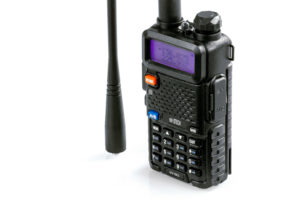 le of radios he had purchased: https://kd8twg.net/2015/10/17/a-quick-and-unscientific-spectral-analysis-of-two-baofeng-radios/.
le of radios he had purchased: https://kd8twg.net/2015/10/17/a-quick-and-unscientific-spectral-analysis-of-two-baofeng-radios/.
Ok, so don’t use these radios. What radio, that meets Part 97 requirements, is available for the price? This was a problem. There was no real option. About the cheapest dual-band radio was $150. DMR radios competed on price and features but, until recently, were only single band. I finally found a better option. Unfortunately, the company has “Baofeng” in the name which makes things even more confusing. A company called “Baofeng Tech” or BTech, is a US based company offering a similar radio called the UV-5X3 for under $60.
The radio looks and acts like a UV-5R. Baofeng Tech updates the firmware, modifies the radio installing better filtering on the transmitter, and includes an easy-to-read nicely printed 85 page manual. The UV-5X3 comes with all the same accessories including belt clip, antennas, charger, and ear piece. All original Baofeng accessories work too. To my surprise, they even squeezed in the 220 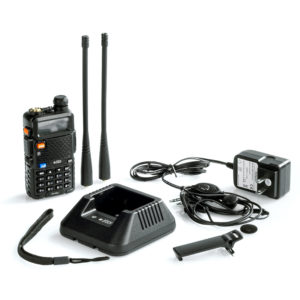 MHz (1.25m) band! Baofeng Tech assured me their radios meet spectral requirements for Part 97. I had mine tested at the Cleveland Hamfest by KD8TWG. On VHF the 3rd harmonic was a little higher than 40db down, UHF was spot-on. The CHRIP free programming software is the only programmer that currently works with this radio. RT Systems UV-5R programmer for the original Baofeng radios does not work with the UV-5X3.
MHz (1.25m) band! Baofeng Tech assured me their radios meet spectral requirements for Part 97. I had mine tested at the Cleveland Hamfest by KD8TWG. On VHF the 3rd harmonic was a little higher than 40db down, UHF was spot-on. The CHRIP free programming software is the only programmer that currently works with this radio. RT Systems UV-5R programmer for the original Baofeng radios does not work with the UV-5X3.
Now there’s no excuse to get a very reasonably priced radio compliant with Part 97 spectral requirements. It even comes with free shipping if bought through Amazon. For someone looking to play around with 220, this is a great tri-bander radio. Check out this radio as an option, from a US company, for new or young hams: https://baofengtech.com/uv-5×3. Product images from Baofeng Tech.
I’ve wanted to install a dual-band DMR mobile radio in the shack. Yeah, all the DMR repeaters in the area are UHF. I like to have the flexibility of a dual-band. Connect Systems was one for the first, if not the first, to release a dual-band DMR mobile radio earlier this year. Talking with Jerry at Dayton (President of Connect Systems), they had just shipped the first batch of CS800D radios and were expecting to get another batch ‘in a couple months.’ I heard very good things from hams that have purchased from Jerry’s company previously. Connect Systems is accessible via email and social media for support, they worked to fully resolve product issues, fixed issues with firmware quickly, and let customers try out their new equipment while seeking feedback. I didn’t hesitate to get on the waiting list.
I finally got the radio at the beginning of August and I like it a lot. The radio itself looks like a Motorola CM300D or nearly identical in layout, including microphone, to the Kenwood TM-281A. Radio 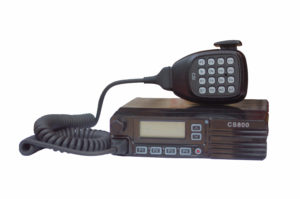 covers VHF: 136-174 @ 50W, UHF: 400-470 @ 45W. The head and microphone are removable and extendable with a cat5 Ethernet cable. It will hold 4,000 channels and 130,000 contacts with firmware updates – more contacts than the ENTIRE DMR-MARC user database! It’s got a couple quarks which I’m told are to be fixed in future firmware releases. Biggest annoyance being the display doesn’t always update after a button is pressed. The programming software is straight forward if you’ve ever programmed a DMR radio before. The Ohio Section website has a pre-built codeplug: http://arrl-ohio.org/digital/digital.html. N0GSG makes a great codeplug editor and codeplug converter that I found useful: http://n0gsg.com/contact-manager/. His editor now supports the CS800D, TYT MD2017 & MD9600.
covers VHF: 136-174 @ 50W, UHF: 400-470 @ 45W. The head and microphone are removable and extendable with a cat5 Ethernet cable. It will hold 4,000 channels and 130,000 contacts with firmware updates – more contacts than the ENTIRE DMR-MARC user database! It’s got a couple quarks which I’m told are to be fixed in future firmware releases. Biggest annoyance being the display doesn’t always update after a button is pressed. The programming software is straight forward if you’ve ever programmed a DMR radio before. The Ohio Section website has a pre-built codeplug: http://arrl-ohio.org/digital/digital.html. N0GSG makes a great codeplug editor and codeplug converter that I found useful: http://n0gsg.com/contact-manager/. His editor now supports the CS800D, TYT MD2017 & MD9600.
The Connect Systems CS800D was a little pricey when I bought it ($399 + $15 for the programming cable) but has since dropped in price to $299. I feel this radio could have been more popular if the radio was not released in batches. Jerry was great about communicating and explaining the situation. Like any distributor, they were beholden to the timetables from their manufacturer. Nothing they could do about it. I think that allowed other options to enter the market sooner and resulted in lost potential sales. It’s a great radio and recommended for someone looking for a dual-band DMR mobile radio from a US based company. CS800D product page: http://www.connectsystems.com/products/top/radios%20CS800D.htm.
If you’ve picked up a CS800D, check the Software page for recent firmware updates: http://www.connectsystems.com/software/software%20CS800D.htm. Product image from Connect Systems.
Technical Specialist reports
Dave – KD8TWG has been busy as usual. In addition to testing radios at the Cleveland Hamfest, he tackled the issue of “operational security.” This has been a topic of discussion in the area as of late and on social media. He was seeing arguments that operational frequencies needed to be obscured for the purposes of “securing” an operation. Without encryption, there is no such thing. As Dave points out, any modern scanner can scan VHF and UHF bands within seconds. It’s even easier with SDR receivers that allow you to look at the entire band scope at once. Check out his post about Hiding Frequencies for “Operational Security”: https://kd8twg.net/2017/08/14/opsec/.
In October, another Section Technical Specialist, Jason – WG8B, gave a presentation to the Dayton Amateur Radio Association about his area of expertise: bike mobile operations. Jason provided feedback on his program:
The briefing focused on using bike mobile capabilities to support 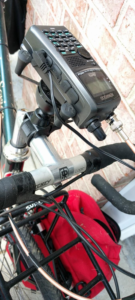 public service events and covered topics such as
public service events and covered topics such as
- Suitable antennas. Bikes are not good ground planes, and dual band antennas are important when supporting public service events from a bike since carrying extra antennas and swapping them out is not easy.
- Speakers and microphones that work while bicycling while allowing you to safely operate a bike.
- Properly mounting equipment to not only protect the equipment but also protect the bicycle and rider.
- APRS operations from a bicycle
Most of the questions revolved around antennas. I won’t repeat specific questions to protect the innocent so to speak, so I’ll just clarify what I think good antenna requirements are for VHF/UHF bicycle mobile operations. First and especially when supporting public service events, omnidrectional antennas are absolutely 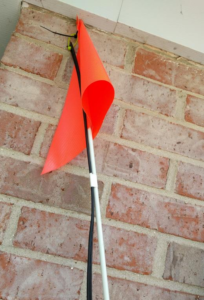 required. On a bike, there is no practical way to steer antennas with directional patterns whether they be gain antennas or magnetic loops. You will be changing direction quite frequently, and you need to hit repeaters from any aspect. Second, high-Q antennas such as magnetic loops require precise tuning, something that’s not possible while on a bicycle. Stick to an antenna that does not require tuning. Your radio should be working for you while on a bike during public service events not the other way around. There’s already enough going on, and safety is first. Third, any antenna bigger or longer than a bicycle flag is not likely safe. There are balance issues with weight above the bike’s center-of-gravity, and just about the worst shape aerodynamically is an antenna. So how hard do you want to pedal? Also, I’ve had problems with low hanging branches with just a bicycle flag. Anything taller is going to be problematic. My recommendation is still to use a dual band J pole like Ed Fong’s DBJ-2 taped to a bike flag or a single band half wave dipole like Larson’s NMO 150B HW. While not the absolutely best antennas performance-wise, they will still hit every repeater in my local area and then some with a 5W HT. And these are very simple and small form factor antennas that just work and won’t get in the way when on a bike.
required. On a bike, there is no practical way to steer antennas with directional patterns whether they be gain antennas or magnetic loops. You will be changing direction quite frequently, and you need to hit repeaters from any aspect. Second, high-Q antennas such as magnetic loops require precise tuning, something that’s not possible while on a bicycle. Stick to an antenna that does not require tuning. Your radio should be working for you while on a bike during public service events not the other way around. There’s already enough going on, and safety is first. Third, any antenna bigger or longer than a bicycle flag is not likely safe. There are balance issues with weight above the bike’s center-of-gravity, and just about the worst shape aerodynamically is an antenna. So how hard do you want to pedal? Also, I’ve had problems with low hanging branches with just a bicycle flag. Anything taller is going to be problematic. My recommendation is still to use a dual band J pole like Ed Fong’s DBJ-2 taped to a bike flag or a single band half wave dipole like Larson’s NMO 150B HW. While not the absolutely best antennas performance-wise, they will still hit every repeater in my local area and then some with a 5W HT. And these are very simple and small form factor antennas that just work and won’t get in the way when on a bike.
Finally, if you would like to see the briefing, I’ve made it accessible here: https://drive.google.com/open?id=0B2Yn-_hki2v0blFnNVVRbW9kc3c
Jason’s presentation has lots of tips and pictures for making a bicycle mobile installation a success. If you would like to have Jason at your meeting, drop him a note!
Thanks for reading and 73… de Jeff – K8JTK